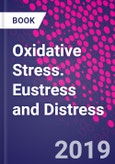- A conceptual framework for studying oxidative stress.
- Processes and oxidative stress responses. Signaling in major enzyme systems (oxidative eustress), and damaging modification of biomolecules (oxidative distress).
- The exposome addresses lifelong exposure and impact on health, nutrient sensing, exercise and environmental pollution.
- Health and disease processes, including ischemia-reperfusion injury, developmental and psychological disorders, hepatic encephalopathy, skeletal muscle disorders, pulmonary disease, gut disease, organ fibrosis, and cancer.
Oxidative Stress: Eustress and Distress is an informative resource useful for active researchers and students in biochemistry, molecular biology, medicinal chemistry, pharmaceutical science, nutrition, exercise physiology, analytical chemistry, cell biology, pharmacology, clinical medicine, and environmental science.
Please Note: This is an On Demand product, delivery may take up to 11 working days after payment has been received.
Table of Contents
I. Conceptual 1. Oxidative Eustress and Oxidative Distress: Introductory Remarks 2. Epistemological challenges of the Oxidative Stress Theory of Disease and the problem of biomarkers 3. Systems Biology and Network medicine: An Integrated Approach to Redox Biology and Pathobiology 4. The Reactive Species Interactome
II. Oxidative Eustress and Distress: Processes and Responses 5. Oxidative stress and the early co-evolution of life and biospheric oxygen 6. How imaging transforms our understanding of oxidative stress 7. In vivo applications of chemogenetics in redox (patho)biology 8. Quantification of H2O2 in cells: methods and significance 9. The Keap1-Nrf2 pathway: From Mechanism to Medical Applications 10. Ferroptosis: physiological and pathophysiological aspects 11. Aquaporins: gatekeepers in the borders of oxidative stress and redox signalling 12. Extracellular superoxide dismutase (SOD3): an antioxidant or prooxidant in the extracellular space? 13. Protein S-glutathionylation and the regulation of cellular functions 14. Dual stressor effects of lipid oxidation and antioxidants 15. Oxidized phospholipid signaling: distress to eustress 16. Redox regulation of protein kinase signaling 17. FoxO transcription factors in the control of redox homeostasis and fuel metabolism 18. Oxidatively generated DNA base modifications: relation to eustress and distress 19. Light-Initiated Oxidative Stress 20. Nutritional Protection against Photooxidative Stress in Human Skin and Eye
III. Exposome 21. Mechanisms integrating lifelong exposure and health 22. Nutrient Sensing, the Oxidative Stress Response, and Stem Cell Aging 23. How exercise induces oxidative eustress 24. Metabolomics as a tool to unravel the oxidative stress-induced toxicity of ambient air pollutants 25. Traffic-related environmental risk factors and their impact on oxidative stress and cardiovascular health
IV. Oxidative Stress in Health and Disease Processes 26. Mitochondrial ROS production during ischemia-reperfusion injury 27. Redox signaling in cellular differentiation 28. Redox regulated brain development 29. Eustress, Distress, and Oxidative Stress: Promising Pathways for Mind-Body Medicine 30. Reactive Oxygen Species and Cancer 31. Perspectives of TrxR1-based cancer therapies 32. Oxidative/nitrosative stress and hepatic encephalopathy 33. ROS Signaling in Complex Systems: The Gut 34. Oxidative stress in skeletal muscle: Unravelling the potential beneficial and deleterious roles of reactive oxygen species 35. Redox Mechanisms in Pulmonary Disease: Emphasis on Pulmonary Fibrosis 36. Dicarbonyl stress and the glyoxalase system 37. Redox distress in organ fibrosis: the role of non-coding RNAs








